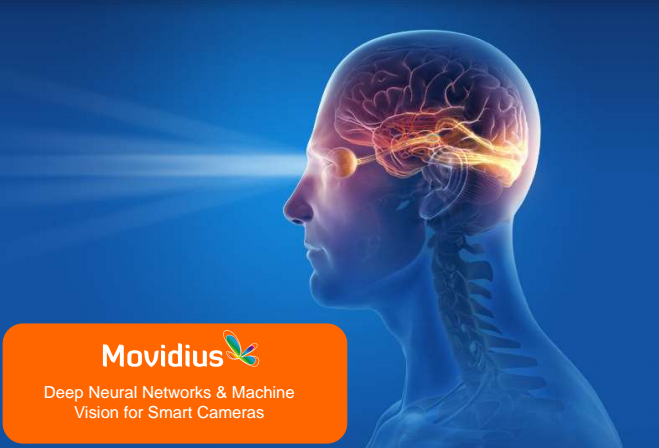Hikvision Partners With Movidius To Make Highly Intelligent Cameras
Intel's Movidius announced that it has partnered with Hikvision, one of the largest surveillance camera makers, to create smarter cameras enhanced by machine learning.
Earlier this year, Movidius launched a deep learning USB stick powered by its second-generation vision processing unit (VPU) called the Myriad 2. The company’s first generation Myriad 1 VPU was used in Google’s Project Tango in 2014.
The Myriad 2's design is optimized for vision processing with a hybrid architecture containing 12 vector processors and 20 hardware accelerators. This means it can deliver higher performance at a lower power consumption level than GPUs or other conventional solutions for processing images and video.
Deep Learning Vs Traditional Algorithmic Approach
Deep learning has gained significant interest from many technology companies because it can be used to solve problems that haven't been strictly defined. This is more effective than the old model, which used algorithms to address very specific problems.
That approach may work well for simple problems, but something like object categorization (which requires the identification of each object and knowledge about how they relate to each other) is much more complex. Deep learning can help a system learn from previous examples to cut down on the work required to define each problem and write a new algorithm to solve it.
Deep learning can also help systems become much more advanced. Movidius and Hikvision say the traditional algorithmic approach can help police find a specific car if the license plates match, for example, whereas cameras with embedded neural networks can use other information about the vehicle to determine if it's a match even if the license plates are different.
However, it’s important to note that object identification is still not perfect, even though Hikvision’s neural networks seem to come pretty close. These devices could still cause problems during investigations if they aren't used carefully by law enforcement.
Get Tom's Hardware's best news and in-depth reviews, straight to your inbox.
On-Device Neural Networks Vs. Cloud-Based Neural Networks
Cloud-based machine learning has its advantages, such as its ability to find answers to complex problems by using the large amount of computing power at its disposal. However, embedded, on-device neural networks can sometimes be a better fit for a variety of solutions and products.
According to Movidius, embedded neural networks can be up to 1 million times more energy efficient than devices that rely on cloud-based machine learning because they are capable of solving simple tasks without any additional hardware. The company also said embedded neural networks have up to 1,000 times less latency and consume up to 10,000 times less bandwidth than devices that rely on cloud-based machine learning because all the processing (inference) is done on the device.
Embedded neural networks powered by chips such as the Myriad 2 VPU also offer more privacy, because the data doesn’t have to go to some company’s servers for analysis. They are also more fault-tolerant. Someone who owns a smart camera, for instance, wouldn’t have to depend on a company to provide the service with 100 percent uptime. People also wouldn’t have to worry about a device not working if its manufacturer goes out of business.
Hikvision's Myriad 2-Powered Cameras
Hikvision, which has a 30 percent market share for IP security cameras and is the largest supplier of cameras in the UK, ranked #1 in the Scene Classification in the ImageNet 2016 challenge. Hikvision was also able to achieve a 99 percent accuracy rate in advanced visual analytics applications, according to Movidius.
Some of the applications for Hikvison's Myriad 2-powered cameras include car model classification, intruder detection, suspicious baggage alert, and seat-belt detection. All of these functions can now be processed locally on the cameras themselves instead of on Hikvision’s servers.
“There are huge amounts of gains to be made when it comes to neural networks and intelligent camera systems” said Hikvision CEO, Hu Yangzhong. “With the Myriad 2 VPU we’re able to make our analytics offerings much more accurate, flagging more events that require a response, while reducing false alarms. Embedded, native intelligence is a major step towards smart, safe and efficiently run cities. We will build a long term partnership with Movidius and its VPU roadmap,” added Yangzhong.
Smart Camera Security
We can’t discuss smart cameras without also mentioning that they seem to be one of the prime Internet of Things (IoT) targets for botnets that are being used to conduct massive DDoS attacks.
The majority of smart cameras and other IoT devices infected by these botnets seem to be those that use default usernames and passwords. Hikvision recently started generating unique passwords for its cameras, so at least this attack vector seems to have been nullified.
However, Hikvision and other IoT device makers will need to do much more to improve the security of their devices, because the increasing frequency and damage caused by IoT-powered DDoS attacks could lead to strict government regulation.
Therefore, IoT device makers need to improve their devices' security not just to protect their customers--which should’ve already been a major concern-- but also to protect themselves from future regulations and the possibility of having new releases delayed by long certification processes.
The first Hikvision cameras to use the Myriad 2 VPU will be shown at the 13th China International Exhibition for Public Safety, which will take place from October 25-28.
Lucian Armasu is a Contributing Writer for Tom's Hardware US. He covers software news and the issues surrounding privacy and security.



